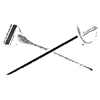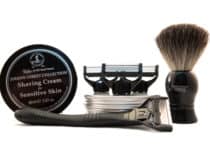Should Men Shave Their Legs? A Complete Guide to Male Leg Grooming

The question of whether men should shave their legs has evolved from a whispered locker room debate to a mainstream grooming discussion. Removing leg hair is no longer exclusively associated with female beauty routines or elite athletes.
Key Takeaways
- Men can confidently choose to shave their legs as a personal grooming preference without stigma.
- Leg shaving offers benefits across athletic performance, aesthetic appeal, and practical hygiene.
- Athletes like swimmers, cyclists, runners, and footballers shave legs to reduce drag, minimize chafing, and aid in injury care.
- Shaved legs enhance muscle definition and improve the visibility of tattoos and skin care product application.
- Proper preparation with warm water, exfoliation, and trimming is essential for a comfortable and safe shave.
- Using quality shaving foam, sharp razors designed for body hair, and careful technique helps prevent irritation and cuts.
- Regular maintenance is required to keep legs smooth, with post-shave hydration critical to avoid dry skin and razor burn.
- Alternative grooming options like trimming provide a low-maintenance way to tidy leg hair without full shaving.
- Men with sensitive skin or certain medical conditions should consult professionals before shaving.
- Ultimately, shaving legs is a personal choice that should align with individual comfort, lifestyle, and grooming goals.
Quick Links
From fitness enthusiasts showcasing muscle definition to everyday men seeking smoother skin and enhanced comfort, male leg grooming has become a personal choice embraced by millions.
Recent surveys reveal that approximately 33% of men trim their leg hair, while 15% opt for complete hair removal through shaving. This shift reflects broader changes in male grooming attitudes, with public figures like Cristiano Ronaldo and Olympic diver Tom Daley normalizing the practice.
Whether you’re an athlete seeking performance benefits, someone wanting to enhance muscle visibility, or simply curious about the smooth skin experience, this comprehensive guide covers everything you need to know about male leg shaving.
The Answer: Yes, Men Can and Should Shave Their Legs If They Want To
The straightforward answer is that men absolutely can and should shave their legs if they choose to do so. In today’s grooming landscape, leg shaving for men represents a personal preference rather than a social taboo. Statistics from grooming industry reports show that 33% of men trim their leg hair and approximately 15% shave completely, indicating widespread acceptance of the practice.
This mainstream adoption extends across various demographics and professions. Many men who shave their legs cite improved athletic performance, enhanced aesthetic appeal, and practical benefits as primary motivators. High-profile athletes like Cristiano Ronaldo and Tom Daley regularly remove leg hair as part of their professional routines, while contestants on shows like “Love Island” have further normalized the trend among younger generations.
The social acceptance of male leg shaving has grown significantly, particularly in Western cultures. What was once considered unconventional is now viewed as another grooming option, similar to facial hair styling or body hair trimming. The decision ultimately comes down to individual preferences, lifestyle needs, and personal comfort levels rather than adherence to traditional gender norms.
Why Men Choose to Shave Their Legs
Men pursue leg shaving for various reasons that generally fall into three main categories: athletic performance enhancement, aesthetic improvements, and practical considerations. Understanding these motivations helps explain why so many men have incorporated leg hair removal into their grooming routine.
Athletic Performance Benefits
Athletic performance represents one of the most compelling reasons many men start shaving their legs. Scientific research and anecdotal evidence from professional athletes support several performance-related advantages.
Swimmers experience the most documented benefits from removing leg hair. Studies indicate that shaved legs can reduce water drag by up to 5%, a statistically significant improvement in competitive swimming where milliseconds determine victory. Beyond the measurable performance gains, swimmers report enhanced water sensitivity, allowing them to “feel” the water better during training and competition.
Cyclists frequently shave their legs to reduce friction and minimize infection risks during crashes. Hairless skin proves easier to clean and bandage following accidents, while the smooth surface reduces discomfort when applying kinesiology tape or receiving post-ride massages. Professional cyclists also report that removing leg hair helps with aerodynamics, though this benefit may be more psychological than measurable. Additionally, shaving their legs helps cyclists streamline their bodies and improve performance, a key factor in competitive cycling.
Runners and footballers benefit from reduced chafing where thick hair might otherwise trap sweat or rub against compression gear and shorts. Footballers who shave their legs often mention improved comfort with shin guards and easier removal of athletic tape after matches. The practice also facilitates better wound care following slide tackles or other contact injuries common in the sport.
Bodybuilders and fitness models represent another group where leg shaving serves clear professional purposes. Smooth skin enhances muscle definition visibility, making vascularity and muscle cuts more apparent both in person and in photographs. This aesthetic advantage proves crucial in competitions where judges evaluate physique details that body hair might obscure.
Aesthetic and Style Reasons
The aesthetic appeal of hairless legs motivates many men beyond the athletic community. Muscle definition becomes significantly more visible on shaved legs, appealing to fitness enthusiasts who want to showcase their training results. This enhanced definition proves particularly striking for men with well-developed quadriceps, calves, and other leg muscles.
Fashion and style considerations also influence men’s decisions to remove leg hair. Those who frequently wear shorts, swimwear, or display leg tattoos often prefer the cleaner appearance that shaving provides. The trend has gained momentum through social media, where fitness influencers and male models regularly showcase smooth, defined legs to their followers.
Television shows like “Love Island” have further popularized male leg shaving among younger demographics. Contestants routinely remove body hair as part of their grooming preparation, normalizing the practice for viewers. This mainstream exposure has helped reduce stigma and expand acceptance of male hair removal beyond traditional athletic contexts.
Tattoo visibility represents another aesthetic consideration for men who shave their legs. Hair can obscure tattoo details on calves, ankles, and thighs, diminishing the artwork’s impact. Many men with leg tattoos maintain smooth skin to ensure their ink remains clearly visible and artistically effective.
Practical and Hygiene Benefits
Beyond performance and aesthetics, practical considerations motivate many men to adopt leg shaving as part of their personal hygiene routine. Hairless legs facilitate easier and more effective application of moisturizers, sunscreens, and other skin care products. The smooth surface allows lotions to distribute evenly and absorb properly, improving overall skin health.
Some men experience reduced skin irritation when they remove leg hair, particularly those with curly hair prone to ingrown hairs or folliculitis. While shaving can initially cause irritation, many find that consistent maintenance actually reduces long-term skin problems compared to leaving thick hair untrimmed.
Medical and wound care considerations also factor into men’s decisions to shave their legs. Healthcare providers often recommend hair removal before surgeries or medical procedures involving the legs. Some men with chronic skin conditions find that hairless legs improve treatment application and monitoring of skin changes.
Climate and comfort represent additional practical benefits. In warmer environments, removing leg hair can reduce sweat retention and associated itchiness. Men living in hot climates or those who exercise frequently often find that shaved legs feel cooler and more comfortable, particularly when wearing shorts or athletic gear.
Potential Drawbacks to Consider
While leg shaving offers numerous benefits, men considering the practice should understand the potential disadvantages and challenges involved. These drawbacks don’t necessarily outweigh the benefits, but awareness helps set realistic expectations and preparation strategies.
Time-consuming maintenance represents the most significant challenge for men who choose to shave their legs. Unlike one-time grooming decisions, leg shaving requires regular upkeep every 2-3 days to maintain smoothness. This ongoing commitment can become burdensome for busy individuals or those with demanding schedules. The process itself takes considerably longer than facial shaving, often requiring 15-30 minutes per session.
Risk of injury and skin irritation poses another concern, particularly for beginners learning proper technique. Razor burns, cuts, and ingrown hairs can occur, especially around bony areas like knees and ankles. Men with sensitive skin, eczema, or other skin conditions may experience heightened irritation. The footballer Marco Asensio’s well-publicized shaving injury serves as a cautionary reminder of the importance of proper technique and preparation.
Financial costs accumulate over time with regular leg shaving. Quality razors designed for body hair, shaving creams, aftershave balms, and moisturizers represent ongoing expenses. Replacement razor blades alone can cost $20-40 monthly for men who shave regularly. While electric trimmers offer some cost savings, they typically don’t achieve the completely smooth results that many men prefer.
Social perception remains a consideration in certain environments, though attitudes continue evolving. Some professional settings, cultural backgrounds, or generational perspectives may still view male leg shaving as unconventional. While this stigma diminishes rapidly, particularly among younger demographics, some men may face questions or comments about their grooming choices.
Health risks, though relatively minor, deserve mention. Repeated shaving creates small cuts in the skin that can potentially lead to infections if proper hygiene isn’t maintained. Men with compromised immune systems or certain medical conditions should consult healthcare providers before beginning regular leg shaving routines.
Step-by-Step Guide: How to Shave Your Legs Properly
Proper technique is crucial for achieving smooth results while minimizing risks and discomfort. The cautionary example of footballer Marco Asensio, who sustained injuries partly due to improper shaving, underscores the importance of following established best practices developed by grooming experts and medical professionals.
Pre-Shave preparation
Effective preparation significantly impacts both the quality of results and the safety of the shaving process. Begin with a warm water rinse, reducing razor resistance and minimizing irritation potential. The warm water opens pores and makes hair follicles more pliable, creating optimal conditions for smooth cutting. Warm water will also soften your leg hair, making it easier for your blade to cut through.
Exfoliation represents a critical preparatory step that many men overlook. Use a loofah, body scrub, or exfoliating mitt to remove dead skin cells from the legs. This process prevents ingrown hairs by clearing away debris that might trap newly cut hair beneath the skin surface. Exfoliating is how you remove dead skin cells, dirt, and oil from your pores, which helps you get a smoother overall result. Focus particularly on areas prone to ingrown hairs, such as the upper thighs and around the ankles.
Trimming long, coarse hair before shaving prevents razor clogging and enables closer results. Use waterproof electric trimmers or a dedicated body groomer to reduce hair length to approximately 1/4 inch. This preliminary step proves especially important for men shaving their legs for the first time or those who haven’t maintained the area recently.
Never attempt dry shaving, as this dramatically increases the likelihood of razor burn, cuts, and skin irritation. The dry approach lacks the lubrication necessary for smooth razor gliding and proper hair cutting. Always ensure the skin remains wet and properly prepared throughout the entire process.
Shaving Technique
Selecting appropriate equipment sets the foundation for successful leg shaving. Use razors specifically designed for body hair rather than facial razors, as they feature different blade configurations and safety features. Products like the Wilkinson Sword Hydro 5 Body Razor incorporate multiple blades and moisture strips optimized for larger surface areas and coarser hair.
Apply a generous layer of quality shaving gel, foam, or cream (for an even more comfortable experience, consider adding a homemade barbershop-style hot towel shave to your routine) to create proper lubrication between the razor and skin. Fragrance-free options work best for men with sensitive skin or those prone to allergic reactions. The lather should completely cover the area being shaved and remain thick enough to provide cushioning throughout the process.
Begin shaving in areas with less dense hair growth, gradually progressing to thicker hair zones. This approach allows you to develop rhythm and technique before tackling more challenging areas. For the closest shave, work against the direction of hair growth using short, controlled strokes. Rinse the razor every 2-3 strokes to clear accumulated hair and maintain blade effectiveness.
Exercise extreme caution around bony prominences like knees and ankles, where the skin stretches tight over underlying structures. These areas require slower, more deliberate movements to avoid nicks and cuts. Consider shaving around rather than directly over the kneecap for added safety.
Include feet and toes in your shaving routine for consistent results, especially if you frequently wear open footwear. Many men overlook these areas, creating an uneven appearance that can appear unkempt. The feet require gentle technique due to the thinner skin and irregular surface contours.
Post-Shave Care
Proper aftercare prevents irritation and maintains skin health following leg shaving. Rinse the freshly shaved area with warm water to remove all traces of shaving products and loose hair. Avoid using hot water, which can increase irritation and cause excessive dryness. Rinsing any excess shaving cream off your skin after shaving is essential for cleanliness and helps prevent clogged pores or irritation.
Pat the skin dry gently with a clean towel rather than rubbing, which can cause additional irritation to sensitive post-shave skin. Leave the skin slightly damp to help lock in moisture when applying aftercare products.
Apply a high-quality, fragrance-free moisturizer or aftershave balm immediately after drying. Products containing aloe vera, vitamin E, or other soothing ingredients help calm potential irritation and restore skin moisture. Daily moisturizing between shaving sessions maintains skin health and can reduce the frequency of ingrown hairs.
Replace razor blades regularly to maintain both hygiene and effectiveness. Dull blades require more pressure and multiple passes, increasing irritation risk. Most men need new blades every 5-10 shaves, though this varies based on hair coarseness and shaving frequency. Signs that indicate blade replacement include tugging sensations, increased irritation, or visible wear on the cutting edges.
Alternative Options: Trimming vs Full Shaving
Not every man requires or desires complete hair removal, making it important to understand alternative approaches to leg grooming. The choice between trimming and full shaving depends on individual goals, time availability, skin sensitivity, and maintenance preferences.
Trimming for Beginners
Trimming represents an excellent starting point for men new to leg grooming or those seeking a compromise between natural hair and complete removal. This approach uses adjustable electric clippers set to 1/4 to 1/2 inch length, creating a neat, uniform appearance while maintaining some natural coverage.
The maintenance requirements for trimming prove significantly less demanding than full shaving. Most men need weekly touch-ups rather than the every-other-day schedule required for smooth legs. This reduced frequency makes trimming practical for busy individuals or those hesitant to commit to intensive grooming routines.
Trimming carries minimal risk of cuts, razor burn, or ingrown hairs compared to wet shaving. The technique involves running clippers over the leg surface without direct blade contact with skin, virtually eliminating injury potential. This safety advantage makes trimming ideal for men with sensitive skin or those prone to skin reactions.
The aesthetic results of trimming provide a middle ground between completely natural and fully shaved appearances. Hair remains visible but appears well-groomed and intentional rather than unkempt. This look works well for men who want tidiness without the dramatic change that complete hair removal creates.
Full Shaving for Smooth Results
Complete leg shaving delivers the smoothest possible results, essential for competitive athletes, bodybuilders, and men seeking maximum aesthetic impact. The process removes all visible hair, creating a clean slate that showcases muscle definition, tattoos, and skin tone without interference.
The time investment for full shaving exceeds trimming significantly, requiring 20-30 minutes per session every 2-3 days. This commitment level demands both skill development and schedule accommodation. However, many men find the routine becomes quicker and easier with practice as technique improves.
Full shaving provides optimal results for athletic performance benefits, particularly in swimming where even minimal hair can impact hydrodynamics. The completely smooth surface also facilitates better application of performance products like warming balms or cooling gels used by serious athletes.
Aesthetic advantages of full shaving prove most pronounced for men with well-developed leg muscles or extensive tattoos. The smooth canvas allows every detail to show clearly, making it the preferred choice for bodybuilders, models, and men who prioritize visual impact.
| Method | Results | Maintenance | Skin Risks | Cost | Ideal For |
|---|---|---|---|---|---|
| Trimming | Tidy, natural | Weekly | Very Low | Low | Beginners, Sensitive Skin, Busy Men |
| Full Shaving | Completely Smooth | Every 2-3 Days | Moderate (burn, ingrown hair) | Moderate to High | Athletes, Bodybuilders |
Preventing and Treating Ingrown Hairs
Ingrown hairs represent one of the most common complications associated with leg shaving, occurring when cut hair grows back into the skin rather than emerging normally. Understanding prevention and treatment strategies helps men maintain smooth, healthy skin while pursuing their grooming goals.
Prevention strategies focus on proper preparation and technique. Regular exfoliation both before and after shaving helps remove dead skin that might trap emerging hair. Use gentle scrubbing motions with a loofah or exfoliating mitt 2-3 times weekly, paying particular attention to areas prone to ingrown hairs like the upper thighs and around hair follicles.
Chemical exfoliation using products containing alpha hydroxy acids (AHA) or beta hydroxy acids (BHA) can prove more effective than physical scrubbing for some men. These ingredients dissolve dead skin cells and help keep follicles clear. Apply these products according to manufacturer instructions, typically 2-3 times weekly on clean, dry skin.
Proper shaving technique significantly reduces ingrown hair formation. Always shave with the grain initially, then against the grain only if necessary for closer results. Use sharp razor blades and avoid excessive pressure, which can force hair to break below skin level rather than cutting cleanly at the surface.
When ingrown hairs do develop, resist the urge to pick or squeeze them, as this can lead to infection and scarring. Instead, apply warm compresses to the affected area for 10-15 minutes several times daily. The heat helps dilate the follicle and may encourage the trapped hair to emerge naturally.
For persistent ingrown hairs, sterilized tweezers can help gently coax visible hair tips to the surface. Clean the tweezers with rubbing alcohol and work carefully to avoid breaking the hair or damaging surrounding skin. If the hair isn’t visible or easily accessible, allow it to resolve naturally rather than forcing extraction.
Men who experience chronic ingrown hair problems despite proper technique may benefit from professional treatment options. Dermatologists can prescribe topical treatments or recommend laser hair removal, which destroys hair follicles and eliminates the possibility of ingrown hairs in treated areas.
Who Should Avoid Leg Shaving
While leg shaving suits most men who choose to pursue it, certain individuals should exercise caution or avoid the practice entirely. Understanding these contraindications helps prevent complications and ensures that men make informed decisions about their grooming routines.
Men with chronic skin conditions like eczema, psoriasis, or dermatitis should consult dermatologists before beginning regular leg shaving. These conditions can be aggravated by the mechanical irritation and chemical exposure associated with shaving products. In some cases, the repeated trauma from shaving can trigger flare-ups or worsen existing symptoms.
Individuals with extremely sensitive skin or histories of severe allergic reactions to grooming products should approach leg shaving cautiously. Consider patch testing shaving products on small, inconspicuous areas before full application. Those who experience significant reactions to facial shaving may find leg shaving similarly problematic due to the larger surface area involved.
Men with bleeding disorders or those taking blood-thinning medications face increased risks from shaving-related cuts. Even minor nicks can bleed extensively in these individuals, potentially leading to complications. Consult healthcare providers about safety precautions or alternative grooming methods if you fall into this category.
Time constraints represent a practical consideration that may make leg shaving unsuitable for some men. The regular maintenance requirements can become overwhelming for individuals with demanding work schedules, family commitments, or other priorities. Inconsistent maintenance often leads to poor results and increased irritation when resuming the routine.
Psychological comfort levels also factor into the decision to avoid leg shaving. Men who feel uncomfortable with the appearance or social implications of hairless legs shouldn’t feel pressured to adopt the practice. Personal grooming decisions should enhance rather than detract from individual confidence and self-expression.
Professional or cultural environments that view male leg shaving negatively may create additional considerations. While attitudes continue evolving, some men may prefer to avoid potential workplace or social complications associated with non-traditional grooming choices.
The Bottom Line: It’s Your Personal Choice
The decision of whether men should shave their legs ultimately comes down to individual preference, lifestyle needs, and personal comfort levels. In 2024’s evolving grooming landscape, there’s no universal right or wrong answer – only choices that align with your goals and circumstances.
The growing acceptance of male leg shaving reflects broader changes in how society views personal grooming and self-expression. With approximately one-third of men already trimming their leg hair and millions more considering the option, the practice has moved firmly into the mainstream. Celebrity athletes, fitness influencers, and everyday men have demonstrated that removing leg hair can serve practical, aesthetic, and performance-related purposes.
For men considering whether to start shaving their legs, remember that hair grows back if you decide the practice isn’t for you. This reversibility makes experimentation relatively low-risk, allowing you to experience the benefits and drawbacks firsthand before making long-term commitments to the grooming routine.
Consider starting with trimming rather than full shaving if you’re uncertain about the commitment level or concerned about potential complications. This approach provides many of the aesthetic and practical benefits while requiring less maintenance and carrying lower risks of irritation or injury.
Confidence in your personal grooming decisions matters more than conforming to others’ expectations or traditional norms. Whether you choose to maintain natural leg hair, opt for regular trimming, or pursue completely smooth results through shaving, the key is selecting an approach that makes you feel comfortable and confident in your own skin.
The most important factor in deciding whether to shave your legs is how the choice aligns with your personal goals, whether they involve athletic performance, aesthetic preferences, practical considerations, or simply curiosity about trying something new. In today’s diverse grooming landscape, the freedom to choose your own approach represents progress toward more individualized and accepting attitudes about male self-care and body hair management.

You might like these!



